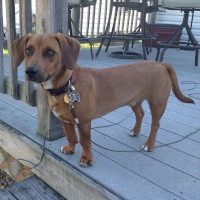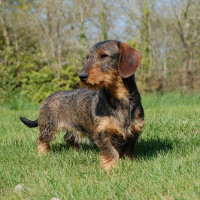Appearance of the Doxle
|
| Doxles are small to medium-sized dogs that vary according to the parent breed they most closely resemble. Dachshunds are available in three sizes: toy, miniature and standard, so your pet's size can also vary. A Doxle's colors are usually beige, black, gold, chocolate, white and brown, and their coat varies but can be fine, hard, stiff and straight. Doxles tend to have fairly long, Dachshund-like bodies and short legs. They are likely to have a long muzzle and long, floppy ears. Their eyes are generally dark, large and round. |
Temperament of the Doxle
|
| Doxles are friendly, affectionate dogs that make excellent pets, especially those with children. But they can also be suitable for older or less active people, and adapt quite well to their environment. They're good with other pets, but because the parent breeds were developed as hunting dogs, they may like to chase small animals, so start training them early and make sure your dog is on a leash when out in public. They don't need a huge amount of exercise to stay in shape. But they are known to chew and bark, so tire them out with regular walks and play sessions to avoid the formation of bad habits. The Doxle is fairly easy to train, although it can sometimes be a little stubborn, but in general it likes to please its human family. They are very alert and loyal dogs who are quite protective of their family and make good watchdogs. |
Needs and activities of the Doxle
|
| The Doxle doesn't need much exercise to stay in shape, so it's suitable for less active people. But a daily walk and a few play sessions will be necessary to keep your pet happy and avoid any misbehavior. They will enjoy playing ball in an enclosed yard, but will adapt very easily to life in an apartment, provided they get out regularly. Doxles like to chew, so be sure to supervise your dog when he has toys to prevent choking. They're good for new pet owners, but socialization and training will be a good idea for this breed. They tend to tolerate heat more than cold, so don't leave them outside for too long in winter. |
Maintenance of the Doxle
|
| A Doxle will need regular grooming to keep it looking good, which will include brushing about three times a week. They don't shed much, and brushing will remove any loose hairs and keep the skin healthy. Doxles don't need to bathe much, unless absolutely necessary. None of the parent breeds are hypoallergenic, so it's unlikely that a Doxle will be either. Try to brush your dog's teeth two or three times a week to avoid dental problems. This breed is prone to ear infections, so check the ears regularly and wipe them with damp absorbent cotton. Check the nails regularly and trim them if they are too long. |









 English (United Kingdom)
English (United Kingdom)